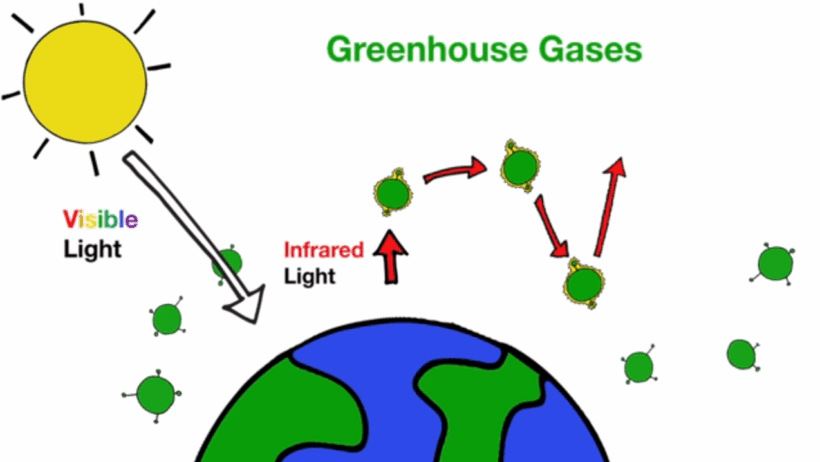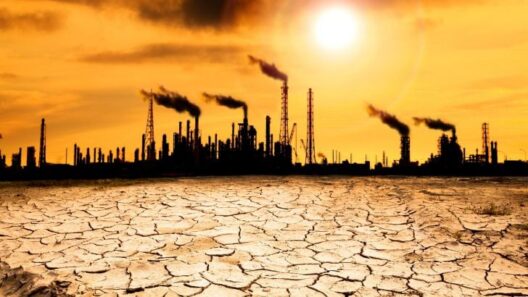As we forge into the 21st century, the discourse surrounding climate change and its implications on global ecosystems becomes increasingly critical. Among the various contributors to this dire issue, carbon dioxide (CO2) emissions stand out prominently. Understanding how these emissions drive global warming is pivotal for grasping the broader phenomenon of climate change.
To comprehend the intricate relationship between CO2 emissions and global warming, it is essential to first recognize the fundamentals of greenhouse gases. Greenhouse gases—primarily carbon dioxide, methane, nitrous oxide, and water vapor—function as an insulative blanket around our planet. When solar radiation reaches Earth, some of this energy is absorbed, heating the surface. The planet, in response, emits energy back into the atmosphere in the form of infrared radiation. However, greenhouse gases trap a portion of this outgoing radiation, resulting in a phenomenon known as the greenhouse effect.
The greenhouse effect is, in itself, a natural process that is vital for maintaining a climate conducive to life. Without it, our planet would be inhospitably cold. However, anthropogenic activities, chiefly fossil fuel combustion and deforestation, have escalated CO2 levels in the atmosphere to unprecedented levels. To illustrate, pre-industrial levels of atmospheric CO2 were approximately 280 parts per million (ppm). Today, however, we have surpassed 410 ppm, a staggering increase that has far-reaching climatic consequences.
The escalation in CO2 emissions directly intensifies the greenhouse effect. The excess CO2 in the atmosphere amplifies the trapping of heat, leading to a rise in global temperatures. This relationship can be graphically represented through what is known as the Keeling Curve, which depicts the ongoing rise in atmospheric CO2 concentrations since the late 1950s. This exponential increase correlates strongly with observed global warming trends.
One must delve deeper to explore the myriad of consequences stemming from rising temperatures. The warming of the Earth’s surface engenders a chain reaction of ecological disturbances. For instance, higher temperatures exacerbate the melting of polar ice caps and glaciers, resulting in rising sea levels. The Intergovernmental Panel on Climate Change (IPCC) highlights that sea levels could rise by over two feet by 2100 if CO2 emissions are not significantly curtailed. Such changes threaten coastal communities and ecosystems alike, leading to potential displacement of populations and loss of biodiversity.
Furthermore, heightened temperatures are intricately linked to alterations in weather patterns. Increased CO2 levels contribute to the frequency and intensity of extreme weather events, such as hurricanes, droughts, and heatwaves. The growing season is also affected; crops may fail to thrive in altered climates, resulting in food scarcity and instability in agricultural markets. These unpredictable conditions pose substantial risks not only to our food systems but also to the overall health of human and ecological communities.
Moreover, the repercussions of increased CO2 emissions extend to the oceans, leading to another critical issue: ocean acidification. As CO2 is absorbed into seawater, it undergoes a chemical reaction, forming carbonic acid. This process reduces the pH of ocean water, posing severe threats to marine ecosystems, particularly coral reefs and shellfish populations. The ongoing degradation of these vital habitats compromises not just marine biodiversity but also the livelihoods of communities reliant on fishing and tourism.
In contemplating the future, it is essential to bear in mind the complex interdependencies between CO2 emissions and various environmental factors. One cannot isolate the issue of climate change from socio-economic paradigms. Vulnerable populations, especially in less developed countries, are disproportionately affected by climate-related disasters. Their limited capacity to adapt exacerbates inequalities, making it imperative to approach climate action from a standpoint of environmental justice.
Interestingly, advancements in climate science do offer avenues for remedial action, shifting our perspective toward possible solutions. Transitioning from fossil fuels to renewable energy sources, such as solar, wind, and hydroelectric power, emerges as a formidable strategy to mitigate CO2 emissions. Investing in energy efficiency and promoting conservation efforts can also substantially reduce our carbon footprint. Furthermore, reforestation and afforestation initiatives play a crucial role in sequestering carbon from the atmosphere, establishing a circular economy that fosters both ecological resilience and economic viability.
Ultimately, the narrative surrounding CO2 emissions and global warming is one of urgency and action. To alter the trajectory of climate change requires a collective awakening to the scientific realities we face. Individuals, communities, businesses, and governments must harness their influence to combat climate change. Citizen engagement, policy reforms, and innovative technologies converge as vital tools in this fight.
The battle against climate change is not merely an environmental issue; it is inherently a moral challenge. As stewards of the planet, we possess the agency to confront the crisis head-on. Understanding how CO2 emissions drive global warming equips us with the knowledge necessary to demand accountability and effectuate meaningful change. By embracing sustainable practices and advocating for informed policies, we can navigate toward a more promising, resilient future.
In conclusion, the complex interplay between CO2 emissions and global warming serves as a clarion call for urgent action. As we stand on the precipice of ecological and social upheaval, transforming our understanding into actionable insights is paramount. The science is clear; the impacts are profound. It is incumbent upon all of us to not only acknowledge but also to act upon this knowledge. The urgency of this moment beckons a collective consciousness toward sustainability and responsibility in the face of global warming.







